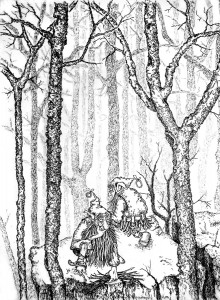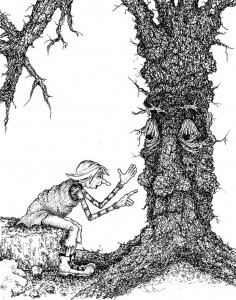The Forest “Folk”
“Stories of old tell that hundreds of years ago, small mountain folk inhabited the rocks and boulders of Backbone Mountain.” Denise Hillman Moynahan, The Great Cavern of the Winds: Tales from Backbone Mountain
After a busy summer and autumn I finally got back to my drawing board. It always feels good, except for the time spent staring at the blank sheet of paper; no different from the way writers feel when they have to write their first line, praying for some inspiration, praying for the perfect first line. My first line is in India ink. There’s no delete button once it’s drawn. But my paper doesn’t stay blank very long.
My studio looks down into the woodlands, into a world of boulders, rocks, and trees. I watch the ever changing scenery from season to season, from day to day; splashes of sunlight, falling leaves, moving shadows, frost, snow, mist and fog. I love the forest in the fog; the patterns of the tree trunks and branches emerging and hiding, their shades of gray getting lighter and lighter as they fade into the background. In fact it was on a foggy day ten years ago that I first saw some “small folk” while I was drawing the view from my studio window. I was almost finished when I looked out and saw two odd looking, small men sitting on the boulder that I was about to draw. They soon faded from my view––but not before I drew them!
“Going to the woods is going home”. John Muir (1838-1914)
During the warmer months the forest calls to me. It lures me in. I don’t argue. I love tramping through the leaves, walking over fallen branches, smelling the earth, feeling the moss on the boulders and the bark on the trees. I often stop to sit on a small boulder or on one of my meditation benches, which are tucked under the forest canopy. In these quiet moments I listen to the voices of the trees––their rustles, their creaks, their snapping twigs, their soft whishing leaves, their whispers.
“I like to take the time out to listen to the trees, much in the same way that I listen to a sea shell, holding it to my ear against the rough bark of the trunk, hearing the inner singing of the sap. It’s a lovely sound, the beating of a heart of the tree.” Madeline L’Engle (1918-2007), A Stone for a Pillow, 1986
The forest forgets that I’m there after while, and that’s when their “folk” start moving about. “Small folk” (who are not necessarily small in size, but have limited supernatural powers) are not uncommon around the world. In fact historically almost all societies have had them. They live amongst the people, although are rarely seen––some reside in kingdoms, others alone; some underground or in trees; some change shape; some are good, some are evil, and some can be both. We know them from our fairy tales––the elves, pixies, brownies, dwarves, goblins, gnomes, trolls and leprechauns to name a few. I especially like the helpful ones, like the brownies, who dwell in Scotland. They’re the most industrious of all. They clean houses, mow fields, and will do all your tedious chores. I don’t see any signs that the “small folk” around here are helpful at all. Certainly none of them has cleaned my house. However, they do let me observe them every so often when I’m out sketching in the forest. In fact at times I wonder if they’re posing for me.
Our local mountain “small folk”, the Alyphanties, (the ones I saw on the boulder) live in the caves. I’ve heard that there are very few Alyphanties left, so I’ve been lucky to see some of them; fortunately their history has been carved into pillars in one of the largest caves, so there’s much we know about them.
But recently I’ve seen other “folk” who aren’t as small. I don’t know what they’re called, so for the time being I’ve chosen to call them the Mountain Woodland folk. I often see their images fade in and out of trees––some in knot holes, some in and under roots, some in nests, and others under leaves; and some live in rather palatial splendor. The trees provide a haven, letting these “folk” sleep, sip tea or meditate. These “folk” even converse with the trees.
Converse? Do these trees actually hear what’s being said? Do they understand? Do they answer? Or have they learned in all their years just to stand majestically and remain mute?
“I am the Lorax. I speak for the trees. I speak for the trees for the trees have no tongues.” Dr. Seuss (1904-1991), The Lorax, 1971
The Lorax is probably correct. There are times when we must speak for them. However, I’m a believer in talking trees. I hear their voices. They hear mine. They have listened. They have answered. They have shared with me some of the secrets of their forest.
It’s getting late in the day. The forest “folk” will soon fade from my sight. It’s time now to leave their sanctuary. I close my sketchbook and go home to my drawing board. Once again, my sheet of paper doesn’t stay blank for long.
To purchase prints of my artwork, see my gallery here. To purchase originals you may contact me directly.
Did you enjoy this post? Why not leave a comment below and continue the conversation, or subscribe to my feed and get articles like this delivered automatically to your feed reader.



Comments
No comments yet.
Sorry, the comment form is closed at this time.